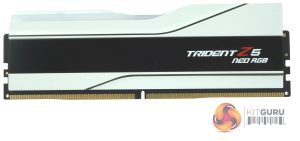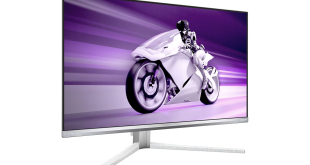

The front of the box that the memory comes in has a cut-out near the top, allowing you to see part of one of the modules. Below this are two award logos, and below these two illustrations of what the memory looks like. The bottom left of the box is home to the AMD EXPO sticker along with the Trident Z5 Neo RGB branding.
The rear of the box has two more cutouts (top and bottom), which let you see the SKU sticker attached to the module. To the right of the bottom cut-out is the product sticker that displays the module density, configuration and what the EXPO profile provides. Below this product sticker is a line of logos representing the motherboard lighting software that the modules support: Asus Aura, ASRock Polychrome Sync, Gigabyte RGB Fusion and MSI Mystic Light Sync.
The heat spreaders on the modules are made from aluminium finished in (in the case of the review sample) matt white with a black brushed-aluminium insert (a Matt black finish is also available). The spreaders give the module a height of 42.8mm. The modules are a single-rank design, under the heatsink, there are eight 2GB SK Hynix chips (H5CG48AEBDX018 – A-die) along with a Richtek RTQ5132GQWF power management IC (PMIC).
The top of the module is home to the RGB defuser bar, which covers eight RGB zones which are controlled by either G.Skill's own controller software or by the motherboard RGB system.
The memory runs at DDR5-4800 with timings of 40-40-40-77-117 (1.10V) natively with the single EXPO profile supporting DDR5-6000 with 26-36-36-96 timings at 1.45V.
G.Skill's Trident Z lighting control software allows you to set up four profiles independently with their own custom light setup. The modules can be set up together or as individual units. The software has fourteen lightning effects and a wide colour palette to set up your desired effect. And as each module can be set up separately, you can come up with some pretty radical effects. There's also a Music Mode which can be customised, but once enabled, all the other profiles are disabled. However, in this mode, the modules will stay dark if there is no audio output.
If you want the modules to sync up with the rest of your lighting scheme, Asus Aura Sync, Gigabyte RGB Fusion 2.0, MSI Mystic Light Sync, and ASRock Polychrome Sync are all supported.
 KitGuru KitGuru.net – Tech News | Hardware News | Hardware Reviews | IOS | Mobile | Gaming | Graphics Cards
KitGuru KitGuru.net – Tech News | Hardware News | Hardware Reviews | IOS | Mobile | Gaming | Graphics Cards
















